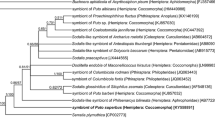Abstract
In obligate symbioses between didemnid ascidians and prokaryotic algae (cyanobacteria), the larvae of the host ascidian usually possess Prochloron cells that are acquired from their mother colony. The process of vertical transmission of the photosymbionts has been histologically described in several species harboring Prochloron in the common cloacal cavity, where Prochloron cells are attached to the hairy surface of the tunic of the larvae during or just before larval spawning. Since the process has never been described in species harboring the photosymbionts in the tunic of the colony, here we describe the histological and ultrastructural process of vertical transmission in a photosymbiotic didemnid, Trididemnum miniatum. No photosymbionts were associated with gametes of the ascidian. Prochloron cells appeared in the epithelial pouch enclosing the embryo and were then incorporated in the tunic of embryos in late embryonic stages. Although Prochloron cells in the tunic of the colony were rarely associated with the host cells, some amoeboid-shaped tunic cells containing Prochloron cells were occasionally found around the epithelial pouch. Therefore, the host cell is thought to be a vehicle transporting the photosymbionts in the tunic of the colony to the tunic of the embryos. The photosymbiont cells were directly embedded in the tunic of the larval trunk. They were not contained in the host cells, as are those in the tunic of the colony. These observations revealed that the mechanism of vertical transmission in T. miniatum is very different from that in didemnids harboring Prochloron in the common cloacal cavity of the colonies, such as Trididemnum cyclops. The mechanisms of symbiont transmission are diverse even within the genus Trididemnum.





Similar content being viewed by others
References
Burighel P, Martinucci G, Zaniolo G (1987) Tissue repair during egg segregation in tunic of the compound ascidian Diplosoma listerianum. Acta Embryol Morphol Exp 8:333–340
Cox G (1986) Comparison of Prochloron from different hosts I structural and ultrastructural characteristics. New Phytol 104:429–445
Groepler W (2002) Ovulation in Diplosoma (Tunicata, Ascidiacea, Didemnidae): a light microscopical study. Helgol Mar Res 56:102–111
Groepler W, Schuett C (2003) Bacterial community in the tunic matrix of a colonial ascidian Diplosoma migrans. Helgol Mar Res 57:139–143
Hirose E (2000) Plant rake and algal pouch of the larvae in the tropical ascidian Diplosoma similis: an adaptation for vertical transmission of photosynthetic symbionts Prochloron. Zool Sci 17:233–240
Hirose E, Fukuda T (2006) Vertical transmission of photosymbionts in the colonial ascidian Didemnum molle: the larval tunic prevents symbionts from attaching to the anterior part of larvae. Zool Sci (in press)
Hirose E, Maruyama T, Cheng L, Lewin RA (1996) Intracellular symbiosis of a photosynthetic prokaryote, Prochloron sp., in a colonial ascidian. Invert Biol 115:343–348
Hirose E, Oka AT, Akahori M (2005) Sexual reproduction of the photosymbiotic ascidian Diplosoma virens in the Ryukyu Archipelago, Japan: vertical transmission, seasonal change, and possible impact of parasitic copepods. Mar Biol 146:677–682
Hirose E, Adachi R, Kuze K (2006a) Sexual reproduction of the Prochloron-bearing ascidians, Trididemnum cyclops and Lissoclinum bistratum, in subtropical waters: seasonality and vertical transmission of photosymbionts. J Mar Biolog Assoc UK 86:175–179
Hirose E, Hirose M, Neilan BA (2006b) Localization of symbiotic cyanobacteria in the colonial ascidian Trididemnum miniatum (Didemnidae, Ascidiacea). Zool Sci 23:435–442
Kott P (1977) Algal-supporting didemnid ascidians of the Great Barrier Reef. In: Taylor DL (ed) In: Proceedings of the 3rd International Coral Reef Symposium. University of Miami, Miami, pp 616–622
Kott P (1980) Algal-bearing didemnid ascidians in the Indo-West Pacific. Mem Queensl Mus 20:1–47
Kott P (1981) Didemnid–algal symbiosis: algal transfer to a new host generation. Proceeding 4th International Coral Reef Symposium 2:721–723
Kott P (2001) The Australian Ascidiacea part 4, Aplousobranchia (3), Didemnidae. Mem Queensl Mus 47:1–408
Lewin RA, Cheng L (1989) Prochloron, a microbial enigma. Chapman, New York
Yokobori S, Kurabayashi A, Neilan BA, Maruyama T, Hirose E (2006) Multiple origins of the ascidian–Prochloron symbiosis: molecular phylogeny of photosymbiotic and nonsymbiotic colonial ascidians inferred from 18S rDNA sequences. Mol Phylogenet Evol DOI 10.1016/j.ympev.2005.11.025
Acknowledgments
This study was supported by a Grant-in-Aid for Scientific Research (#16570081) from the Japan Society for the Promotion of Science and the 21st Century COE Program of the University of the Ryukyus. Larval sampling and TEM observation were carried out at the Sesoko Station (Tropical Biosphere Research Center, University of the Ryukyus) and at the Shimoda Marine Research Center (University of Tsukuba: contribution # 721), respectively.
Author information
Authors and Affiliations
Corresponding author
Additional information
Communicated by S. Nishida, Tokyo
Rights and permissions
About this article
Cite this article
Hirose, E., Hirose, M. Morphological process of vertical transmission of photosymbionts in the colonial ascidian Trididemnum miniatum Kott, 1977. Mar Biol 150, 359–367 (2007). https://doi.org/10.1007/s00227-006-0378-1
Received:
Accepted:
Published:
Issue Date:
DOI: https://doi.org/10.1007/s00227-006-0378-1




